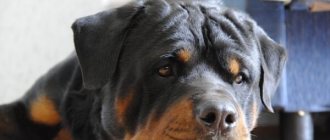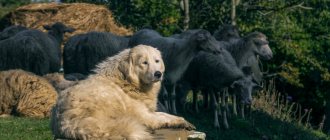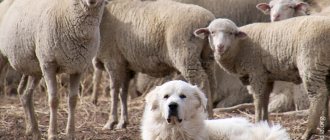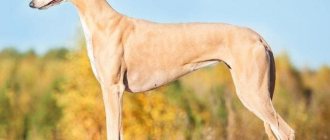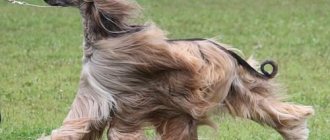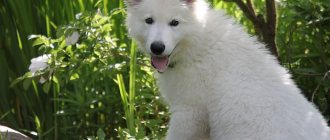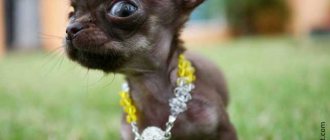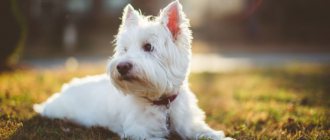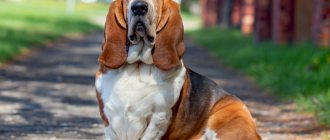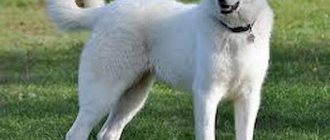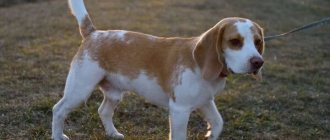The common wording “fighting breed” is not officially registered. It is more of an amateur designation for varieties of dogs that shared common physical and psychological qualities that made them suitable for fighting.
After this bloody entertainment was banned in many countries, the principles of breeding fighting dogs (also called gladiators) underwent changes. Breeders began to select individuals with the gentlest disposition for breeding in order to ultimately obtain a dog with a reduced level of aggressiveness. However, not all once formidable fighters succumbed to “re-education.” Many breeds still retain a ferocious temperament, especially if they were trained by non-professionals.
Bullmastiff
These dogs are absolute record holders for jaw clenching force. According to the calculations of dog handlers, this figure for bullmastiffs is 155 kg per square meter. cm.
These dogs can be called the result of a selection error. They were once bred in England to help foresters catch poachers. However, quite quickly the bullmastiffs were removed from service: they were excellent at finding violators, but often bit them to death. At the same time, in ordinary life, the dog, thanks to the efforts of breeders, no longer suffers from unmotivated aggression.
Bullmastiffs are strong and tall dogs. Their height at the withers reaches 70 cm, weight – 60 kg. They effectively use physical strength in battle: they try to knock the enemy down and grab the most tender places - the throat or stomach.
They have a tough temperament, are fierce and do not succumb to any tricks, which is why security forces often use them in special operations.
Bull Terrier
A compact but very strong dog with a well-deserved reputation as a killer. With a height of 30–40 cm at the withers and a weight of only 13 kg, the Bull Terrier will emerge victorious in a fight with almost any opponent.
A unique feature is a complete set of teeth. Total 42: 20 on the upper jaw, 22 on the lower jaw. The normal force of jaw compression is approximately 1100 N, but appropriate training allows you to increase it to 1450 N. At the same time, the bull terrier holds the record for the duration of a bite: it is capable of holding a victim for up to three hours.
Tough in battle. He does not strive to finish off the enemy as quickly as possible. Before killing, the bull terrier inflicts multiple wounds so that the enemy bleeds, tries to gnaw the carotid artery or jugular vein.
Staffordshire Bull Terrier
A breed of fighting dogs, a mixture of terriers and bulldogs. When it was created, the goal was to create a compact but scary animal. Small sizes (height - up to 40 cm, weight - up to 17 kg) made it possible to effectively use dogs in fights held indoors.
The dog has very powerful jaws and great bite force. With an average weight of 25 kg, it can hang in the air for a long time, clinging to any object with its teeth.
Strong and muscular, the Stafford is a natural leader. Today, breeders have worked hard on his character, as a result of which, instead of a born fighter, a companion has appeared who has high intelligence and is able to visibly express a whole range of emotions.
They do not show ferocity towards people, although animal aggression remains in their character. But even in battle, they do not have the goal of killing the enemy, their main function is to protect the owner.
Group of fighting terriers
This is not a pure breed group. The word “terrier” itself is translated as “earthen” or “burrow”. The dogs were bred exclusively for hunting; they are small in size and cute in appearance.
As for fighting species, their ancestors are not only Terriers, but also world-famous Bulldogs. The breeds were actually bred for fighting, most often dog fighting. But in the mid-19th century, this entertainment became forbidden. Therefore, all such fighters were subject to selection work, during which the characters of the dogs were radically changed.
Now most of the former bloodthirsty dogs have become cute pets. However, fighting terriers are often used for service.
Bull Terrier
The shortest of the group, it reaches 30-40 cm at the withers and weighs 8-13 kg. These are small, stocky dogs with pronounced, well-developed muscles. A distinctive feature is an elongated convex skull and a round bridge of the nose, which gives the animal a terrifying appearance. A fighting feature is large teeth in a full set (42: 20 in the upper jaw and 22 in the lower jaw). Acceptable colors: white or colored (brindle, brown, red), spots are allowed.
The character of the Bull Terrier depends on heredity. Those who have never kept the breed often talk about the disadvantages. If the litter is of high quality and without deviations, then the puppy will develop normally, without outbursts of aggression or anger towards humans. Basically, Bullies are affectionate to their owners, love children, they are active and playful. Good physical shape makes them unsurpassed defenders; they treat strangers with caution, and with proper training they will never be the first to attack.
Among the minuses, it is worth considering jealousy, intolerance of loneliness, and cockiness. These pets will never miss an opportunity to show their leadership among other pets. To avoid this, you need to properly socialize the animal from the first days of training: introduce it to people, to tanks, and walk it in noisy places.
Animals are rarely kept outside; they are intended for apartment and home keeping. Due to their short fur, Bullies are susceptible to sudden climate changes and cannot tolerate severe frosts or abnormal heat. They are easy to care for, but require long walks and constant training.
Staffordshire Bull Terrier
A fighting breed bred from Molossian dogs, bulldogs and terriers for fighting. Breeders were in dire need of a compact, but strong and scary animal, as a result of which the Bull Terrier appeared. At the withers he is 35-40 cm and weighs 11-17 kg . Due to their small size, dogs were the best figures in dog fights held in closed pubs and restaurants.
Externally, Stafford is short, short-legged, but strong and muscular. The owners note that the animal can smile and be sad, this is due to the accumulation of wrinkles on the face and head. Dogs' ears are semi-erect, long, but not large. These Bulls look more like Bulldogs than Molossers.
Dogs have not been used as fighting dogs for a long time; their character has been completely changed to suit the desires of dog lovers. Therefore, Staffbulls are considered one of the most loyal and best family fighting dogs. They are companions rather than working service pets.
Dogs are loyal to their owner, love and protect children, and are non-aggressive towards people, even strangers . Genetically, Bulls may not like their brothers, but they are not aimed at eliminating the enemy. Representatives of the breed strive to demonstrate their leadership and establish themselves in the team through physical superiority.
Despite the fact that the breed is completely human-oriented, Staffbulls are often stubborn and try to take a dominant position in the house. They need serious education and physical activity, otherwise the animals are unpretentious.
American Pit Bull Terrier
Daughter breed of the Staffordshire Bull Terrier. It was developed in America after fight clubs for animals were banned in England. Bull Terriers were brought to the continent to improve their skills. As a result of selection, the Pit Bull Terrier, or Pit Bull for short, appeared.
The breed is characterized by extreme instability in appearance and growth. At the withers, individuals reach from 43 to 53 cm , resembling either bulldogs or terriers. A characteristic feature is a fit body and long muscular legs . The muzzle can be either short, wide or elongated. The color can be solid or brindle (except merle).
Despite its high popularity in America and the world, active use in the 19th and 20th centuries, the breed is still not recognized by the world canine organization. Dogs do not have a clear standard; breeding, to a large extent, is carried out randomly. This is why Petes can differ greatly in appearance and character.
Pit bulls are the most aggressive and uncontrollable of the fighting terrier group, all because the development of character is difficult to keep track of. Not every nursery has family books, so it is difficult to analyze the shortcomings of a particular puppy’s ancestors. Dogs are prohibited in many EU countries and America. Other states have introduced strict rules for keeping and walking the breed, because it is classified as potentially dangerous.
In fact, healthy adequate Pit Bull Terriers do not have aggression towards humans. Their anger is directed at animals, in particular dogs. Well-mannered Pete will be affectionate and friendly even to strangers.
American Staffordshire Terrier
American Staff or Amstaff is a breed branch originating from the Pit Bull. Unlike their brothers, Amstafs are registered and recognized by the world. They have a softer character, although they are still not as kind as Staffbulls. Their direct goal is to protect themselves and their owner, and eliminate the threat.
They are similar in appearance to Pita: long-legged, tall (43-48 cm), strong and muscular. However, their type is terrier. The muzzle is not wide and elongated with a deep stop and a minimum of wrinkles. Unlike Staffbulls, Staffies' ears are cropped. In addition, this breed cannot have white, liver or tan colors.
By character, Amstaf is a true leader, a winner . Animals are hardy, strong, with a high pain threshold and a strong nervous system. They show good results in training and are better suited than others for service in military structures. Dogs are friendly to people, although strangers should stay away from them.
American Bulldog
The breed was bred a couple of centuries ago specifically for fighting: its representatives participated in the so-called “bull baiting”. Later, bullying of bulls was banned, and bulldogs (another name is ambuli) began to fight with other dogs.
There is a stereotype regarding their character: according to the majority, they are uncontrollable, extremely aggressive, and dangerous to animals and people. There is a deal of truth in it. By nature, bulldogs are indeed like that, but the degree of their fighting qualities largely depends on their upbringing.
These dogs do not know fear, are extremely loyal to their owner, have a high level of intelligence, and are patient. Among the official characteristics of the breed is an increased level of aggression towards other dogs, so this is their advantage, not a disadvantage.
The physical characteristics of ambuli are considered unique; they surpass all other gladiators in endurance and strength. The bite force reaches 72 atmospheres, but this parameter is not the main thing. Much more important is that the dog's jaws move horizontally and vertically. Experts compare its bite to the work of a hairdressing machine.
Bottom line
Today we talked about representatives of fighting dog breeds. And although many owners of the above-described breeds claim that their pets are the kindest creatures, we should not forget to be careful when communicating with them. Bred for fighting and fighting, they have forgotten their purpose, but the smell of blood and provoking situations can remind them of who they really are.
People with unstable psyches, physical disabilities, lack of experience in training dogs, as well as children and adolescents, are better off choosing representatives of other breeds in order to avoid irreparable situations.
What breeds did we forget to write about in this list? Write your answers in the comments to the article. TopCafe will be happy to read all your comments.
Editor's note: This article has been updated since its original publication in September 2022.
American Pit Bull Terrier
The breed is not officially recognized; in many countries its representatives are prohibited from breeding due to the increased level of aggressiveness and often complete uncontrollability. The dog's rage flares up instantly, the reaction is lightning fast. But this does not diminish her popularity. Even the police use pit bulls - they have an excellent sense of smell and are easily trained to detect explosives and narcotics.
The dog's bite force is 126 kg per square meter. cm. This is not the highest figure, but there are more deaths as a result of fights with a pit bull than, for example, with a Rottweiler. The fact is that pitas, having grabbed onto the victim, lose their heads and stop hearing and seeing anything around them. They simply tear the enemy to shreds, not responding to commands or attempts to stop the fight. In America, the pit bull is considered the most dangerous of all dogs.
By nature, these dogs are extremely aggressive towards other animals; ferocity towards humans has recently become less and less common. Breed standards have not been defined, pit bulls can look very different from each other, fluctuations in height reach up to 10 cm. They were bred specifically for fighting in clubs.
Read White dogs - 20 breeds with names
What do the statistics say?
The most accurate statistics on bites can be considered using the example of the United States. According to a CDC study, about 4,700,000 people are bitten by dogs each year, with 800,000 injuries requiring medical attention. The US population is about 325.7 million, which means that one in 69 people is bitten by a dog. In terms of the number of bites, the leader is... baby Chihuahua.
Small dog breeds are more likely to bite people
The Petes came in second place, but more important were the tragic consequences of their attacks. Below is the number of deaths from different dog breeds in the United States from 2005 to 2022:
- Pitbull – 284;
- Rottweiler – 45;
- German Shepherd – 20;
- Mixed breeds - 17;
- American Bulldog - 15;
- Mastiff/Bullmastiff - 14;
- Husky - 13;
- Labrador Retriever - 9;
- Boxer - 7;
- Doberman - 6.
In defense of pit bull terriers, staff dogs, mastiffs and other “dangerous” breeds, it should be noted that most attacks are committed by mestizos or “folk” bred dogs, which do not officially belong to any breed, and are essentially mongrels. They are classified and their “fightiness” determined by eye. Strong, smooth-haired with cropped ears means Pit, with jowls means Mastiff, black and tan means Rottweiler or Doberman. Therefore, it is difficult to talk about objectivity.
American Staffordshire Terrier
Close relatives of pit bulls, however, this breed is recognized by the canine community and has clearly defined standards. The same fact has a positive effect on the reputation of dogs: there are fewer unbalanced, disobedient, aggressive individuals among them, since breeding is carried out under control.
The dog is physically very strong (even an adult man will not be able to keep the Amstaff on a leash if he is interested in something) and has an unbending will to win. Such a dog fights to the end. It is impossible to imagine him chickening out or giving up. An excellent guard, protects not only the family, but also the territory. Does not waste energy on barking or growling, attacks silently and sharply.
The breed was bred specifically for fighting; it is aggressive and hardy. Bite force – 120 cm per square meter. cm, while the main energy is directed not at holding, but at “breaking away”. That is, the dog tears pieces out of the victim’s body.
He has well-developed intuition, due to which he predicts the enemy’s further movements. He senses intonation well, but there is a danger in this: if he speaks in a raised voice, the dog may attack the person who has irritated the owner.
Boerboel
The second name of the breed is the South African Mastiff. This is a very serious dog, which should be raised by a person who knows all the nuances of the breed. There are Boerboels specially bred for fighting. And this line is not suitable for home keeping. Dogs are very aggressive and very difficult to deal with.
A socialized Boerboel should perceive all family members and react distantly to strangers. But even so, when talking with friends, you need to keep an eye on the dog, because one wave of your hand in your direction can be interpreted as an act of aggression. And the consequences will be natural.
The owner must behave with the Boerboel authoritatively, peremptorily, but respectfully. Dogs begin to confront each other in adolescence, and here you can’t let go.
Training a Boerboel is a slow and tedious task. This breed is not stupid, but constantly strives to check on the owner. Even if the dog obeys unquestioningly, there is no guarantee that the same reaction will happen next time.
You need to exercise a lot with a dog - only in this case you will get a faithful, manageable friend. This is a slow maturing breed, so be patient.
Video: Boerboel
Rottweiler
The reputation of Rottweilers as evil, aggressive animals was created by stupid owners. In fact, the natural ferocity in the character of these dogs is easily suppressed by education, so reliably that later, if you want to develop a fighting temperament, it has to be “awakened” on purpose. But the owner who has achieved success in this matter can fully expect that sooner or later the dog will attack him.
Bite force – 150 kg per square meter. cm, the jaws act like scissors - the upper one overlaps the lower one, which makes it easy to tear out pieces of flesh. In some countries, the dog is officially listed as not recommended for pets, since collisions with representatives of this breed cause the greatest number of deaths.
The Rottweiler has a reduced pain threshold, is fearless, and is quick to attack. But the dog rarely attacks first; it is too phlegmatic for this. The main characteristics of the Rottweiler are intelligence, stubbornness and leadership qualities. Any actions of the dog in battle are thought out; he does not give up or retreat. And his strength and physical parameters (height - up to 70 cm, weight - up to 50 kg) allow him to emerge victorious even from fights with the most dangerous opponents.
Maintenance, care
Boxers are one of the breeds that are only suitable for apartment or home keeping. Outdoor enclosures or kennels with a chain are not suitable for four-legged pets. It is especially worth noting that dogs do not tolerate elevated temperatures very well, and therefore there is a high risk of getting heatstroke while walking. The owner is advised to closely monitor the health of the four-legged pet.
With the onset of cold weather, it is recommended to purchase warm overalls for a boxer for walking. The animals have short fur and no thick undercoat. The animal must be walked at least twice a day. It is worth considering that this breed is very active and loves to play, and therefore it is worth purchasing various toys for it that you can take with you outside.
As for care, there are no special requirements. Pets need to have their ears and teeth cleaned weekly, as well as undergo regular examinations of their visual organs and mucous membranes for the presence of inflammatory processes.
It is not recommended to bathe a Boxer frequently; this can only be done if the dog gets into the mud a lot during a walk. Due to the short coat, dogs practically do not shed, and therefore they need to be combed only once every 7 days, using a special rubber mitten with small fibers.
Feeding
Both natural and prepared foods are suitable for this dog. As for the first type of nutrition, it is worth paying attention to some features. The dog must be provided with all the nutrients that will ensure the health of the pet.
Meat products include all parts of slaughtered cattle, rabbit meat, poultry, and some types of fish. Eggs contain protein, but it is recommended to give dogs only raw yolks or hard-boiled eggs.
The meat itself can be given raw, half-raw or boiled. Only pork needs to be excluded. You should be very careful with raw products; meat may contain the causative agent of such a dangerous and fatal disease as Aueschi. It is destroyed only during prolonged cooking.
All bones must be removed from boiled pieces of rabbit or chicken, because... When chewed by a dog, sharp fragments can injure the digestive tract.
It is not recommended to remove all fat from meat products. Very fatty pieces are boiled, and the fat is removed from the cooled broth; it can be added to the main feed). A small amount of fat allows the body to absorb fat-soluble types of vitamins.
Fish is given to diversify the diet; it is necessary to remove the bones and boil it, because... in its raw form, this product leads to digestive upset.
Their grain feeds can be given:
- brown brown rice;
- barley;
- vermicelli;
- special dog biscuits.
The grain must be given in the form of porridge to steam the indigestible peel.
Ready-made food contains all the valuable components that dogs need. Such food is easy to give and convenient to store, even in large quantities. If the puppy ate exactly such food, then switching to natural food is not recommended.
A Boxer will eat just fine on the same type of food; if it is necessary to switch the animal to another brand, this is done gradually to avoid upset of the digestive system.
Upbringing
The educational process includes such important aspects as:
- toilet training your pet;
- habit of eating at a certain time;
- teaching a young dog the basic commands “sit”, “lie down”, “come to me”, “near”, etc.
Such commands will help the owner control the animal as it grows up. It is necessary to start the training process with simple commands, and they are worked on until the puppy understands what is required of him.
It is not recommended to end the training if the dog still does not understand what the owner wants from it. The easiest way is to reward your pet. To understand the “come to me” command, you need to call the puppy and show him a treat. Then the treat is hidden and the command is repeated. If there is no positive reaction, then the pet must be gently pulled towards you by the leash and reinforced with a treat.
Parenting mistakes
Many owners overprotect the puppy, trying to protect it from getting into various situations. As a result, the dog grows up timid and fearful. Excessive gentleness leads to the fact that the pet develops mental disorders. A very strict owner has every chance of raising a boxer that is dangerous to society, and therefore it is not worth using aggressive methods in training.
Doberman
According to one version, the creator of the breed worked as a tax collector and needed a reliable, brave, strong and intelligent guard. This is how the Doberman was formed. Today it is one of the most common breeds in the world.
Though slender and graceful in appearance, Doberman Pinschers are nevertheless very strong. Aggression is usually motivated: the dog will attack if its owner or property is threatened. If not properly trained, it can react ferociously to strangers and other animals.
The dog's bite force is 142 kg per square meter. cm. In addition, Dobermans are swift and resilient - irreplaceable qualities in a fight. Attacks at high speed - up to 38 km/h.
But their main feature is considered to be their intelligence, which is exceptional for the canine world. They are always extremely attentive, sensitive to any movements. The Doberman is called the smartest of all dogs.
Pros and cons of the breed
Like all dogs, the English Bull Terrier has its own advantages and disadvantages.
| pros | Minuses |
| Has intelligence | Difficult to train |
| Suitable for apartment living | Does not tolerate frost and heat well |
| Shedding is not pronounced | Presence of genetic diseases |
| Easy to care for | Suitable for experienced dog owners only |
| Playful and active | Difficult to educate, complex character |
| Acts as a companion | Prone to aggression |
| Has security and protective qualities | Doesn't get along with other pets |
| Strong and dexterous | Jealous, capricious, vindictive |
| Fearless | Free range is prohibited |
Akita Inu
A Japanese breed originally used for baiting wild boars and bears. Later, Akitas became regular participants in dog fighting. By the way, this entertainment was not banned in Japan, although its rules were relaxed in accordance with the requirements of the time.
Cute in appearance, Akitas have a very complex character and a fierce temperament. Powerful and persistent, this dog is aggressive even towards humans and is difficult to train.
Read Neapolitan Mastiff - Italian watchman
The breed is American Akita. Taking the Japanese dog as a basis, breeders enhanced some of its qualities, transforming the hunter into a guard. In the American version, dogs have reduced aggressiveness and increased controllability - they never attack without a command. A high level of distrust allows you to perform excellent security functions.
Varieties
There are several sub-breed groups of boxers.
German
These dogs are the only ones recognized by the International Canine Federation. The breed is universal and exhibits excellent guarding qualities. The character of Boxers is balanced, they are incredibly loyal to their owner. Aggression is not typical of German dogs.
American
This breed doesn't actually exist. After the end of World War II, the German boxer gained enormous popularity not only in European countries, but also in America. The Americans took several puppies to their homeland, and it was they who became the founders of a new breed group. Such dogs have a lighter build and a smaller head, but only experienced dog handlers can notice such differences.
Brindle
Most popular among dogs with brindle coloration. The suit is characterized by the presence of stripes of dark color, which are located along the main color. The coat of such dogs should be short, shiny and close to the body. Thanks to this coloring, the muscles on the pet’s body appear more prominently.
Cane Corso
A large and strong dog, up to 68 cm at the withers, weight - 60 - 70 kg, very muscular. Initially, in her homeland, Italy, she was a companion of shepherds - she drove buffaloes and other cattle. In addition, she served as a security guard - guarding the farmer’s property. According to another version, it comes from ancient Roman fighting dogs that accompanied gladiators in battle.
He has a balanced character and well-developed intuition, easily determining who is a friend and who is an enemy. In the absence of pathological cruelty, it sometimes shows aggression towards other dogs and small children, but this is successfully suppressed by education. In a dangerous situation, he acts without waiting for a command.
Puppies
To get a good pet you need to choose the right young dog, so what criteria should a boxer meet?
Choosing a puppy
Before making the final choice in favor of this or that animal, you need to pay attention to what the dog looks like, it should be healthy and playful. Conscientious owners will be happy to talk about the bitch and all available offspring with detailed characteristics of the puppies. Who has what behavior, habits, taste preferences.
Dogs from a kennel, as a rule, have already been examined by a veterinarian, but a potential owner should not be lazy and look into their ears and eyes themselves. Any discharge or damage may indicate the health of the dog. The dog's coat should be shiny and smooth, and there should be no stiffness in its movements. Animals at such a young age have a playful character and a good appetite. A sleepy state often occurs after feeding. If possible, you should wait a little longer to reduce the risk of illness if the puppy appears lethargic.
Price
The cost of a Boxer will be influenced by the place where the puppy was purchased, as well as the further use of the dog:
- You can purchase a pet from private individuals for 5,000 – 8,000 rubles;
- kennels offer dogs that are not suitable for breeding for 10,000 - 20,000 rubles;
- nurseries that provide documents for puppies with titled parents will set a price of 60,000 or more.
Alabai
Another name is the Central Asian Shepherd Dog. The main function of the dog was once to guard the herd. But due to their strength and ferocity, the Alabai quickly attracted the attention of dog fighting organizers. In Asian countries, these entertainments are still common.
The breed has not been subjected to selection correction. All the qualities that are available now were inherent in Alabai initially. He is observant, distrustful of strangers, but has a medium level of aggression, which is explained by his original purpose: a herding dog should not have a passion for killing. At the same time, in battle, Alabai is fearless and unbending.
The dog is very large, looks like a bear. A characteristic feature is late development. Alabai matures only at the age of 4; before that he is a puppy both in physical condition and in level of intelligence.
Group of fighting mastiffs (Molossoids)
It is difficult to imagine a dog from the Molossoid group as a domestic sofa dog. Indeed, mastiffs were bred to serve humans: hard work, baiting animals, gladiator fights. They were trained for fierce battles, so modern representatives of the breeds have still not lost their former courage.
A common feature for all mastiffs is size. Animals are large and dangerous for a stranger or dog. They require a lot of space, training, food and attention.
Caucasian Shepherd Dog
The Caucasian is distinguished by its unpretentiousness, remarkable strength and thoughtfulness, which is why the breed is widely in demand as a guard dog. In battle he shows courage, endurance and aggressiveness. This is one of the largest dogs in the world, and its physical parameters (normal weight is up to 70 kg, but can reach 100) make it easy to defeat representatives of other breeds in the ring.
The complex nature of the pet requires the owner of such a dog to take a careful approach to its upbringing. Caucasians are touchy, vindictive, very independent and prone to thinking. They cannot tolerate aggression directed at themselves and can give non-standard reactions. They carry out commands only after thinking and are generally not known for their speed of action. But in the process of achieving the goal, nothing can lead them astray.
Features of training
Fighting dogs need to be trained from a very early age . These breeds are genetically programmed to be aggressive and want to get into fights, so puppies need socialization as early as possible. The pet will have to devote all his free time, walk with him every day for 2-3 hours (exclusively in a muzzle and on a leash), and provide him with the necessary level of physical activity. In the process of education and training, you must adhere to the following rules:
- always show your dominant and leading position, not allowing the dog to insist on its own (the owner must be an indisputable authority);
- if necessary, show rigidity and rigor;
- give commands correctly, clearly and firmly;
- do not use physical violence.
Fighting dogs must be trained
You should not leave small children with a fighting breed dog, as children can provoke a surge of aggression.
It is best to entrust the training of a dog prone to aggression to an experienced instructor who has experience in handling such animals . But the training process is not limited to one or even two completed courses; the dog will have to be trained throughout its life, while constantly keeping it under strict and vigilant control.
American Bandog
The fruit of the deliberate work of breeders to obtain the ideal dog for fighting. From his ancestors he inherited a powerful physique, strong jaws, menacing appearance and aggressiveness.
However, it quickly became clear that the ideal did not work out: the bandog, for all its stature (dogs are never shorter than 50 cm and lighter than 45 kg), is not able to withstand even half of a fight with a pit bull. He lacks persistence and perseverance: after capturing, he does not hold the victim, but immediately releases him.
Bite force - from 1180 to 1460 N. They are often unbalanced, since the canine community does not recognize the breed, standards for breeding have not been developed, and it is carried out uncontrollably. It is worth noting that the first individuals were kept in cages by their owners and released only at night to protect the territory.
Bully kutta
This breed, originally from India, is little known among us. The Bully Kuta is one of the four strongest dogs in the world. It has ancient origins, the name is derived from the words “very wrinkled”. Indeed, the skin on the neck of these dogs gathers into numerous folds - a great advantage in battle, preventing the enemy from causing serious damage to the throat.
The dimensions are impressive, the dog’s height reaches 112 cm, weight – 90 kg. Representatives of the breed are fearless and do not retreat even from an enemy much larger than themselves. They are actively used to participate in underground battles in India and Pakistan.
Stubborn, smart, prone to dominance, dangerous if not properly trained. The level of aggressiveness is so high that it is impossible to appear on the street with a bully without a muzzle. It has powerful jaws and loves to gnaw and chew. In battles he usually wins due to his ferocity and enormous physical strength.
What makes a dog aggressive?
Master. Not always intentionally. Any dog requires serious education, an understanding of its place in the hierarchy and an example to follow. What is important is the owner’s attitude towards her, his behavior in society and, of course, regular communication. A puppy raised with love will be friendly and balanced. If the owner is psychologically unstable, then the dog often adopts his habits.
Lack of experience. Some breeds are more docile, others are clearly dominant. Keeping and raising “serious” dogs requires experience and knowledge of the basic aspects of psychology, the ability to recognize and correct unwanted behavior in a timely manner.
Inappropriate position in the hierarchy. A dog is a social animal. You can give a lot of examples when owners cannot put themselves on a higher level and this results in problems. With small breeds it is a little easier. You can learn not to provoke them into conflict and leave them alone; they are unlikely to bite anyone to death anyway. But a guard dog, which itself decides from whom and when to defend the territory, is very dangerous. In addition, at a certain moment, she can forcefully prove to the owner her position in the pack or try to “put in place” other family members. So in 2022 in Moscow, a Cane Corso dog killed its owner, but this is rather an exception.
Any dog requires serious education, an understanding of its place in the hierarchy and an example to follow.
Insufficient socialization. The importance of communication and general development is confirmed by the fact that dogs that are trained for fighting are kept on a chain in strict isolation. And trimming their ears and tail not only makes them less vulnerable, but also difficult for the enemy to understand. It becomes more difficult for him to read mood or intention through normal body language signals.
No load. Any active and powerful dog should splash out its energy in a peaceful way; sport is an excellent option. Without this opportunity, the animal may become depressed, aggressive or uncontrollable.
Genetics. The tendency to aggressive behavior and mental disorders may be congenital. It is more often observed in dogs of “inter-entry” breeding, when close attention is not paid to their health or appearance. The standards of all breeds recognized by the FCI state that any signs of aggression or cowardice are disqualifying factors and individuals are excluded from breeding. Someone will say that he doesn’t need documents and will mate an evil bug with a male dog from the neighbor’s yard. But even here it is the owner’s fault - did he save? A descendant of fighting dogs may be particularly “lucky” to come across. Puppies that were rejected for some reason can be found at poultry markets and, naturally, no one will tell you what their grandfather did.
How to reduce the number of aggressive dogs
All over the world, schemes are being developed, bans, rules and taxes are being introduced, but all measures are not effective enough. Most animal psychologists say that the only way to reduce the number of aggressive dogs and attacks on people is to control who will own the dog, in what conditions it will be kept and for what purposes it will be used. For example, issuing a permit after completing a course, helping a person choose the right breed. In the CIS, dogs that attack a person usually:
- They walked without a muzzle or leash, and sometimes without their owner;
- Were kept in families of people addicted to alcohol or drugs;
- Subjected to violence;
- Walked by a drunk owner or child.
It is only man who makes a dog a fighting and aggressive dog.
Saying that all dogs of the so-called "fighting breeds" are potential killing machines is similar to saying that the children of a person who once broke the law will certainly become criminals.
Dogue de Bordeaux
An ancient breed originally from France, it was mentioned in ancient written sources. Initially they were used for hunting and protection, in particular to accompany butchers bringing their products to the market. The dogs' appearance alone scared away all sorts of adversaries and wild animals - with moderate height (up to 65 cm), Dogues de Bordeaux can reach 100 kg of weight.
Later the dogs were used in battles. They have an instantly flaring aggressiveness and are extremely dangerous if their owner is attacked. They never retreat, they fight to the end, they are ready to die for victory.
Read What is the difference between a husky and an Akita Inu: choosing a puppy, photos of mixed breeds
At the same time, the rest of the time the dogs are sweet, good-natured and even lazy. The character of the breed has been radically changed through selection. This is an excellent companion, calm, attentive, intelligent and loving children.
Ca de bou
At one time, this breed was used to restrain bulls (even the name is translated from Spanish as “bull dog”). This alone shows the strength of her jaws. Later, the ca de bou was used by bullfighters, it was supposed to distract the attacking animal. Then she became a constant participant in dog fighting.
Today this is all in the past, although physical parameters and moral qualities allow the “bull dog” to be an excellent fighter.
It reaches a height of 40 cm, a weight of 60 kg, powerful and muscular, but completely non-aggressive, although distrustful of strangers. She never rushes into battle first unless there is an immediate threat to her owner. However, it is impossible to stop the attack of an enraged ca de bou, and if the dog has been pushed to its limits, it will win the fight.
Tosa Inu
An ancient Japanese breed, "samurai dog". In peacetime, she took part in dog fights, which is why she became very popular in her homeland. Over the centuries, this breed has developed qualities that bring victory in a fight.
In size, Tosa Inu are quite large: up to 60 cm at the withers (but there are also higher ones, the standard does not limit this parameter), weight varies greatly, and can reach 80 kg. Their bite force is comparable to that of pit bulls; even puppies can easily chew through the trunks of young trees.
She is resilient, capable of fighting for hours without a break, fearless and patient. Makes decisions independently. A unique quality: Tosa Inu themselves develop a battle strategy and are distinguished by their ability to learn, that is, they take into account their past mistakes. By nature - a categorical companion; they cannot live without a family.
It is almost impossible to purchase a real Tosa Inu outside of Japan. The versions of American and European breeding, according to Eastern breeders, are very different from the original and in a real fight will not perform as well as the “samurai dog”.
Laws regarding aggressive dogs
The officially recognized term is “dangerous dog breeds”; in the CIS they are called “fighting dogs”. In many countries of the world they are prohibited from import, keeping or breeding. Such decisions regarding individual breeds were caused by some tragic events. In Germany, Great Britain and some US states, children die as a result of bites.
Back in the 3rd century BC. The Romans first passed an act according to which the owner was liable if his dog attacked a person. In 849, King Alfred the Great of England passed a law requiring the owner of a dog that bit someone to pay a fine of 6 shillings. In the Victorian era, Londoners were already paying 40 shillings per bite.
In 1991, England introduced a ban on four dog breeds: pit bull terrier, Tosa Inu, Dogo Argentino, and Fila Brasileiro. After a child died from a pit bull bite.
In many European countries (France, Germany, Great Britain, Denmark, Sweden) and in New Zealand, the keeping of dogs of potentially dangerous breeds is prohibited or limited, which are recognized as:
- Pit bull terrier;
- American Staffordshire Terrier;
- Staffordshire Bull Terrier;
- Bull Terrier;
- Bulli kutta;
- Neapolitan Mastiff;
- American Bulldog;
- Dogo Argentino;
- Dogue de Bordeaux;
- Bullmastiff;
- Caucasian Shepherd Dog;
- Their mestizos and some others.
In addition, owners are required to take out insurance, which pays out to the victim of an attack in the event of a bite. Dogs are walked in special areas and must be on a leash. They are tested annually for aggression.
In Russia, the government also approved a list of potentially dangerous breeds. Initially it consisted of 69, then it was reduced to 12. From 01/01/20, owners of dogs on the list are prohibited from walking their pets without a muzzle and a leash. There must be warning signs on private property where a dog is kept.
According to statistics, people are more often bitten by dogs that have not been trained on the training ground and have practically never been taken outside the yard.
English Mastiff
An ancient breed, it was originally used in popular entertainment in medieval England - bear fights and baiting of wild animals. It is huge in size: up to 75 cm in height and up to 100 kg in weight. Wrinkled skin on the face and neck protects against bites. Attacks silently, does not like to voice at all. Follows commands without hesitation. He wins not due to speed, but due to physical strength and power.
Today mastiffs are not used in fighting. Breeders have softened the dog's character, and it is more often used as a companion. True, he retains the traits of a stern disposition - he does not like to play or have fun, he is always wary and ready to defend himself.
Is it worth getting a dog with fighting qualities?
All fighting dogs have a complex and independent disposition, which not everyone can cope with. Having a pet with fighting qualities only makes sense for an experienced dog breeder with a strong character, who has enough time to work with the animal and is ready to take responsibility for it. It is highly not recommended for inexperienced people who have no experience communicating with canines to adopt a fighting dog.
A soft, unsure of his own abilities and inconsistent owner will turn his ward into a monster, posing a potential danger not only to others, but also to himself.
In the hands of an inexperienced person, fighting dogs become extremely dangerous.
My friend has an American bulldog at home. Of course, he doesn’t attack everyone, but his whole appearance suggests that you can’t joke with him. As soon as someone raises their voice at the owner, not to mention the physical impact, the dog’s bar instantly drops and he rushes into battle.
Fila Brazilero
As the name suggests, the breed was developed in Brazil. Outwardly similar to the English Mastiff, although slightly inferior in size. The original purpose was to search and capture runaway slaves. The character of the dog fully meets this goal and has not changed over the centuries.
In battle, he is fearless and insensitive to pain. The main method of action is to grab and hold.
The level of aggressiveness is extremely high, and this is recorded in the breed standards. Cannot stand being touched by strangers - and this is also the norm. Can behave ferociously in everyday conditions, for example, at exhibitions - this will not result in disqualification. Due to its aggressiveness and willfulness, it is prohibited for breeding in some countries.
Shar Pei
Few people today perceive the Shar Pei as a fighting dog; their cute, folded appearance is misleading. However, these folds served as protection for the dog from bites. Muscular legs, a powerful body and strong jaws - all this made Shar Peis good fighters, and Chinese peasants loved to have fun watching their fights.
Compared to modern fighting dogs, Shar Peis lose physically, although their character is capable of ensuring victory. Observant, always wary, sensitive and distrustful, they are courageous in fights and do not like to give in. A well-developed intellect allows you to choose combat tactics. But their low level of aggressiveness does not give them a chance to survive in the fight against pit bulls or Rottweilers. Even targeted selection failed to increase the ferocity of these dogs.
Most fighting dogs today are quite manageable in the hands of sensible owners. However, you should not treat them carelessly and frivolously. Few of them tolerate the close attention of strangers well; the reaction can be extremely unpleasant and lead to serious consequences.
Why is the world against “fighting dogs”
The public's perception of certain breeds is highly dependent on the media. It changes from time to time and is not always based on facts or statistics.
In the 70s, Dobermans became famous. These dogs were associated with mafiosi, who raised them to be aggressive watchdogs. In the 80s, the same fate befell German shepherds, and in the 90s, Rottweilers. At the same time, in many countries, the favorite breeds of criminals remained pit bulls and bull terriers, strong and easy-to-keep dogs with a terrifying appearance. Naturally, no one wanted to raise them to be loyal companions; the dogs were trained to be aggressive, which irrevocably damaged their psyche.
